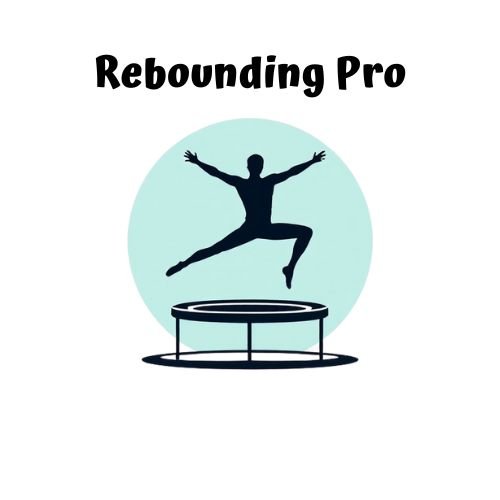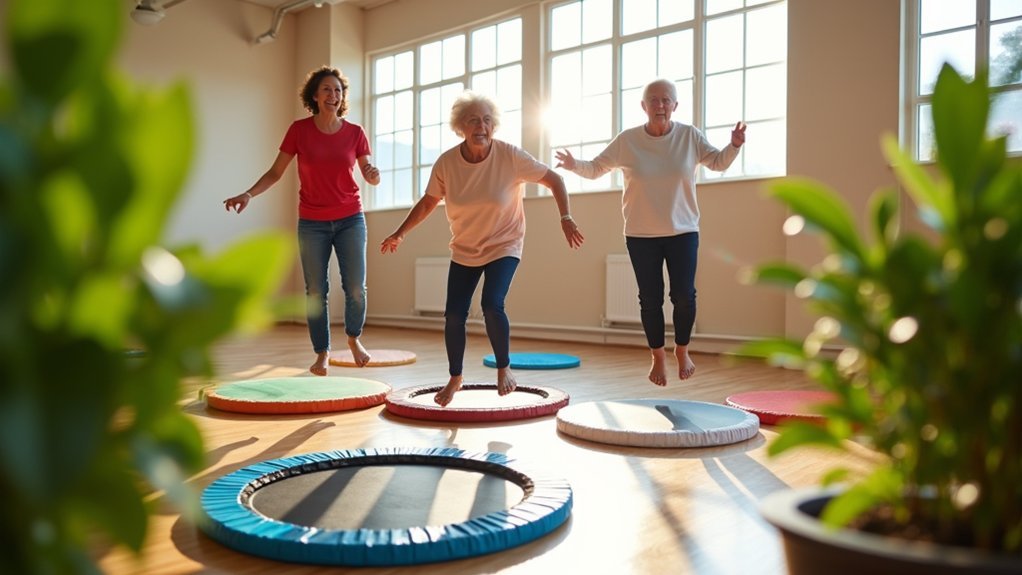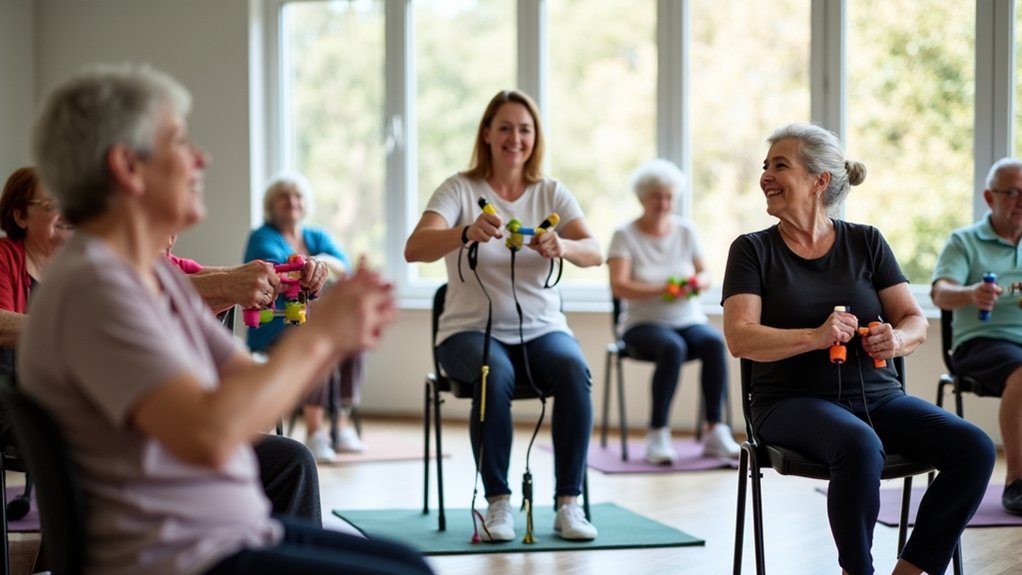Rebounding on a mini trampoline offers seniors a joint-friendly workout that improves balance, bone density, and cardiovascular health with minimal impact. Start with a stable trampoline featuring a safety handlebar, and begin with gentle bounces for just 1-2 minutes. Wear supportive shoes, maintain proper posture, and gradually increase your session length as comfort improves. The gentle bouncing motion not only strengthens your body but also boosts mental wellness through increased blood flow to the brain. Discover how this accessible exercise can transform your golden years.
Why Rebounding Exercise Benefits Seniors’ Joints

While many traditional exercises can strain aging joints, rebounding offers a uniquely gentle alternative that’s ideal for seniors. The trampoline’s flexible surface absorbs shock, dramatically reducing stress on your knees, hips, and ankles compared to high-impact activities like running.
When you bounce, you’re promoting circulation of synovial fluid that lubricates your joints while strengthening the surrounding muscles that provide essential joint support. This combination helps reduce inflammation, pain, and improves stability.
The gentle bouncing motion also enhances your balance and coordination by challenging your proprioceptive system, potentially reducing fall risk by up to 35%.
Additionally, the improved circulation from this low-impact cardio workout helps remove metabolic waste from joint tissues, further decreasing stiffness and discomfort. For seniors with arthritis, it’s especially beneficial to incorporate quality mini-trampolines that provide appropriate stability while enjoying these joint-friendly benefits.
Getting Started: Safety First on Your Mini Trampoline
You’ll need a stable mini trampoline with a safety handlebar and proper weight capacity to guarantee your rebounding experience is safe and effective.
Set up your equipment on a flat, obstacle-free surface with enough overhead clearance, and inspect it regularly for wear or damage.
Begin with gentle movements while maintaining proper posture—feet flat on the mat, knees slightly bent, and core engaged—before gradually increasing your session length beyond the initial 1-2 minutes. Wearing comfortable, supportive shoes will enhance your stability and help prevent potential injuries during your rebounding workout.
Choose Your Trampoline Wisely
When selecting a mini trampoline for seniors, safety features should top your priority list. Look for models with protective padding that covers springs to prevent foot injuries. A sturdy, adjustable handlebar provides essential stability for those with balance concerns.
Consider these key factors:
- Bounce mechanism – Bungee cords offer a quieter, gentler bounce than traditional springs, making them ideal for joint sensitivity.
- Weight capacity – Verify the rebounder can safely support your weight.
- Foldability – A foldable design allows for convenient storage when not in use.
The right trampoline makes exercise both safe and enjoyable. Many seniors prefer models with anti-slip feet for stability on various surfaces, and adjustable tension to customize workout intensity as fitness improves. Quality rebounders like JumpSport Fitness Trampolines provide exceptional stability and a forgiving bounce that’s perfect for older adults.
Proper Setup Matters
Setting up your mini trampoline correctly forms the foundation of a safe and effective workout routine. Place your equipment on a firm, flat surface to prevent shifting during use. Clear the surrounding area of furniture or objects that could cause injury if you accidentally step off.
If you’re using a model with handlebars, adjust them to your height before beginning. This provides vital support for balance and stability during your exercises. Marc Montemerlo recommends starting with a modified lunge on the Rebounder to check your stability before beginning any bouncing movements.
Always check that the frame is sturdy and that the mat shows no signs of wear or tears before each session.
Perform regular maintenance checks to confirm all parts remain in good working condition.
Remember that proper setup isn’t just about safety—it creates an environment where you can focus on your movements without worrying about equipment failures.
Start With Basics
Before stepping onto your mini trampoline for the first time, safety precautions and proper technique must become your top priorities.
Begin with very short 1-2 minute sessions to assess your comfort level, gradually building to 5-20 minutes as your endurance improves.
Maintain proper form by keeping your core engaged and knees slightly bent in an athletic ready position. Start with gentle movements like health bounces (where your feet don’t leave the mat) or slow marching in place. Remember to monitor body responses for any discomfort, soreness, or joint aches during and after your rebounding sessions.
- Warm up thoroughly with stretches focused on feet, ankles, calves, and hips before each session
- Use the safety handlebar for support if balance is a concern
- Listen to your body—stop immediately if you experience dizziness or sharp pain
Balance-Building Bounce Routines for Fall Prevention
Falls represent one of the greatest health risks for seniors, yet they’re often preventable with proper balance training. Trampoline exercises offer an ideal solution by improving coordination while reducing joint strain.
Start with simple marching in place to enhance stability, then progress to side-to-side steps that strengthen your hip and core muscles. Gentle bouncing serves as an excellent warm-up, preparing your body for more focused exercises like heel raises that build lower body strength. Engaging in twist jumps can significantly increase abdominal muscle flexibility and provide better overall body control.
Begin with gentle marching movements, then incorporate lateral steps to activate core stability before progressing to targeted strengthening exercises.
For maximum safety, use a trampoline with a stability bar, wear non-slip footwear, and keep movements controlled.
These bounce routines not only prevent falls but deliver additional benefits including improved cardiovascular health, muscle toning, and enhanced lymphatic circulation.
Listen to your body throughout each session and consult with healthcare professionals before beginning.
Heart-Healthy Rebounding for Cardiovascular Strength

Your mini-trampoline can transform into a powerful heart health tool, offering circulation-boosting benefits without stressing your joints.
You’ll gradually build cardiovascular endurance through rhythmic bouncing patterns that elevate your heart rate while maintaining proper form. Start with gentle health bounces to improve lymphatic circulation while keeping your core engaged.
Remember to monitor your pulse rate during workouts, start with just 5-10 minutes daily, and always keep a sturdy chair nearby for balance support when beginning your rebounding routine.
Low-Impact Circulation Boosters
While many seniors shy away from cardiovascular exercise due to joint pain concerns, rebounding on a mini-trampoline offers a truly heart-healthy alternative. Your circulatory system responds remarkably to the gentle bouncing motion, improving blood flow throughout your body without stressing your joints.
- Each bounce creates a momentary weightless state followed by increased gravity, creating a pumping effect that enhances lymphatic circulation and helps remove toxins.
- Your heart rate increases to moderate-to-vigorous intensity levels, comparable to jogging, but with 80-90% less impact on your knees and hips.
- Short 10-15 minute sessions are enough to boost your VO2 max and improve oxygen utilization, making daily activities feel easier.
These gentle movements provide cardiovascular benefits while protecting your joints from the harsh impact of traditional exercises. The gentle bouncing technique helps stimulate the lymphatic system to effectively flush toxins from the body while supporting overall joint health.
Rhythmic Endurance Building
Building endurance becomes a rhythmic journey on the mini-trampoline, where your heart gains strength through gentle persistence rather than intense exertion. Each bounce creates 1.5-2 times your body weight in gravitational loading, efficiently strengthening your heart muscle while protecting your joints. Trampoline exercises provide low-impact workouts that are especially beneficial for seniors looking to maintain cardiovascular health without strain.
You’ll notice your stamina improving as you alternate between gentle jogging and side-to-side movements, creating natural intervals that optimize oxygen uptake and boost mitochondrial function.
| Exercise | Duration | Benefits |
|---|---|---|
| Gentle Bounce | 2 min | Heart rate elevation |
| March in Place | 1 min | Core stabilization |
| Side Steps | 1 min | Balance improvement |
| Arm Circles | 1 min | Upper body integration |
| Seated Bounce | 1 min | Recovery phase |
Try barefoot rebounding to strengthen foot arches and improve stability. Adding music can help maintain rhythm while reducing perceived effort through natural endorphin release.
Pulse-Raising Safety Tips
Raising your heart rate safely becomes a priority on the mini-trampoline, where cardiovascular benefits multiply without stressing aging joints.
Start with gentle marching or small bounces for 3-5 minutes before gradually increasing intensity to 50-70% of your maximum heart rate.
Monitor your body’s signals while rebounding:
- Keep bounce heights low with slightly bent knees, maintaining soft landings to protect joints
- Watch for dizziness or unusual shortness of breath—stop immediately if these occur
- Make sure your heart rate returns to near baseline within minutes after exercise
For best safety, position your rebounder on a flat surface with clear surrounding space, and consider using handrails for balance if needed. This low-impact aerobic exercise offers excellent benefits while being gentle on your body.
Remember to wear supportive footwear or bounce barefoot on a soft trampoline surface.
Bone Density Boosters: Weight-Bearing Trampoline Movements

Three key factors make trampoline exercise particularly effective for maintaining and improving bone density in seniors. The gentle impact forces stimulate bone remodeling while the supportive surface reduces joint strain. Research shows that consistent mini-trampoline workouts can increase BMD in the spine and hip—critical areas for preventing osteoporotic fractures. This is especially important as competitive trampolinists demonstrate significantly higher bone density measurements in these areas.
| Movement | Benefit | Frequency |
|---|---|---|
| Gentle Rebounds | Stimulates osteoblast activity | 3-5 minutes daily |
| One-Leg Balance | Targets hip and spine density | 30-60 seconds per side |
| Supported Knee Lifts | Enhances weight-bearing benefits | 8-12 repetitions |
You’ll see the best results with 30-minute sessions three times weekly. The combination of dynamic movements and balance work creates ideal bone-strengthening conditions while improving muscle strength that further supports skeletal health.
Gentle Strength Training While Rebounding
Strengthen your body while minimizing joint strain through trampoline-based resistance training. Your gentle bouncing creates natural resistance as your muscles work against gravity and momentum changes. This low-impact approach builds strength without stressing sensitive joints—perfect if you’re managing arthritis or joint pain. Rebounding can be particularly beneficial for seniors as it stimulates lymphatic circulation while providing a gentle workout option.
- Perform heel raises and gentle marches to strengthen your calves, thighs, and glutes while improving stability and gait.
- Add arm circles and coordinated movements to enhance upper body strength, shoulder mobility, and posture.
- Incorporate seated bounces and side-to-side steps to continuously engage your core stabilizers, reducing back pain.
You’ll notice improved functional strength for daily activities as these exercises simultaneously work your balance, coordination, and muscular endurance—all while protecting your joints from high-impact stress.
Mental Wellness Benefits of Regular Trampoline Sessions
Serenity awaits on your mini-trampoline, offering benefits far beyond physical fitness. Each gentle bounce increases blood flow to your brain, enhancing memory and concentration while creating stronger neural connections.
You’ll notice your stress melting away as endorphins flood your system during rebounding sessions. The rhythmic bouncing naturally relaxes tense muscles and elevates your mood, potentially easing symptoms of anxiety and depression. Even a short 10-minute session can trigger endorphin release, promoting a positive outlook that lasts throughout your day.
The cognitive challenge of maintaining balance and coordination engages multiple brain regions simultaneously, keeping your mind sharp and potentially slowing cognitive decline.
Don’t underestimate the social benefits, either. Joining group rebounding classes creates valuable connections with peers, fostering a sense of community and reducing feelings of isolation—a powerful combination for your emotional wellbeing.
Progressing Your Routine: From Beginner to Confident Bounder
The journey from first-time bouncer to confident trampoline enthusiast happens one gentle hop at a time.
Begin with the health bounce—feet hip-width apart, making small, controlled movements while holding onto a support if needed. As your balance improves, gradually extend your sessions from 5 to 15 minutes and incorporate more dynamic movements.
Your progression path might look like this:
- Start with basic health bounces and marching in place, focusing on micro-knee bends and core engagement.
- Add variations like side-to-side bounces and “in and out” foot steps once you’ve mastered the fundamentals.
- Introduce arm movements and eventually light hand weights to enhance muscle strength once your balance feels secure.
For additional stability, try the knee bounce with legs positioned wide and practicing a gentle side to side sway for improved balance.
Always listen to your body and progress at your own pace.
Combining Rebounding With Other Senior Fitness Activities
Creating a well-rounded fitness routine means integrating your trampoline workouts with other senior-friendly activities for maximum health benefits.
Try adding light hand weights during gentle bounces to improve strength, or incorporate balance exercises like standing on one leg between rebounding sessions.
Enhance your rebounding routine by alternating weighted bounces with simple balance poses for a complete senior fitness experience.
Boost cardiovascular health by alternating between rebounding and brisk walking segments. For cognitive stimulation, bounce to music or play memory games during your workout.
Consider joining group classes where you’ll benefit from social interaction while a trained instructor guarantees proper form. Regular participation in these exercises can reduce the risk of nonfatal falls that affect millions of seniors annually.
Remember to wear comfortable clothing and supportive shoes, and always start with a stable mini-trampoline featuring handlebars.
Get medical clearance before beginning, then progress gradually as your confidence and fitness improve.
Frequently Asked Questions
Can I Use a Trampoline With a Hip Replacement?
You shouldn’t use a trampoline with a hip replacement. It’s high-impact and risks dislodging or damaging your implant. Consult your doctor first and consider safer alternatives like swimming or walking instead.
How Does Rebounding Compare to Swimming for Seniors?
Both rebounding and swimming offer you low-impact workouts that are gentle on joints. You’ll strengthen your cardiovascular system with either activity, but rebounding may improve your balance more while swimming provides greater overall flexibility.
Will Trampoline Exercise Help With Sleep Quality?
Yes, trampoline exercise can improve your sleep quality by releasing endorphins, reducing stress, and providing physical exertion. The rhythmic bouncing stimulates your vestibular system, promoting relaxation and potentially enhancing your overall sleep patterns.
Are There Specific Rebounding Exercises for Seniors With Diabetes?
Yes, there are specific rebounding exercises for your diabetes management. Try health bounces, slow jogging, toe touches, vertical jumps with arm movements, and straight ahead holds while monitoring your blood sugar levels.
Can Trampoline Workouts Help Improve Cognitive Function?
Yes, you’ll experience cognitive benefits from trampoline workouts. Research shows they improve attention, executive function, and processing speed, especially in seniors over 70. The balance and coordination demands enhance brain plasticity and neural connections.
In Summary
You’ve discovered a gentle yet powerful way to stay active in your golden years. By incorporating trampoline workouts into your routine, you’ll improve balance, strengthen bones, boost heart health, and elevate your mood. Start slowly, prioritize safety, and gradually increase intensity as your confidence grows. Remember, it’s never too late to bounce your way to better health and mobility!





Leave a Reply